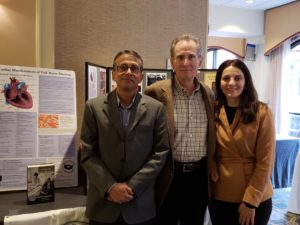Highlights from LDA/Columbia 19th Annual Scientific Conference Lyme & Tick-Borne Diseases: Turning the Corner Through Research
Global Lyme Alliance (GLA) recently attended a conference jointly organized by Lyme Disease Association, Inc. and Columbia University. The meeting featured speakers from around the country who gave updates about diverse subjects relevant to Lyme and tick-borne diseases.
Dr. Claudia Molins from the Centers for Disease Control and Prevention (CDC) discussed her work on finding metabolic signatures for Lyme disease. These are byproducts of metabolism that are specific to Lyme patients, and since they are unique to different diseases, identifying these signatures might be useful as a diagnosis of Lyme disease. Even more compelling, they may yield clues about which subsets of patients are unlikely to be cured by first-line antibiotic therapy.
Another speaker, Dr. William Robinson of Stanford University, spoke about his collaboration with Dr. John Aucott of Johns Hopkins University, who is funded by GLA. Together, they work on samples from the landmark SLICE study, which deciphers immunological data from patients in various stages of Lyme disease. Dr. Robinson’s talk focused on antibody production in Lyme disease. These can be both protective against the pathogen, as well as directed against the host, that may help to explain both the failure to protect against the microbe as well as to harm the patient, painting a complex picture of the immune response against Borrelia. He also discussed how these may correlate with disease stage.
A potential new therapeutic drug candidate for Lyme disease was presented by Dr. Kim Lewis, a GLA grant recipient. His group has rediscovered hygromycin A, a previously known drug that was never screened for activity against B. burgdorferi, which it kills without any effect on other bacteria. Thus, it may potentially be developed as a treatment for Lyme disease that will not harm the commensal human microbiome.

From the University of Maryland, Dr. Utpal Pal, who is on the GLA scientific advisory board, the conference heard of his findings about BBA57, a Borrelia gene that is critical for the initial infectivity of the bacteria into a mammalian host, via various strategies to block the host immune system. Curiously, mutations in BBA57 only transiently stop bacterial infection, and bacteria that rebound from the initial delay are able to persist in the host, attesting to the difficulty of bacterial eradication.
Dr. Shannon Delaney from Columbia University spoke about patients who suffer from symptoms that are similar to, but subtly different from Lyme disease. Her study reveals that infection by Borrelia miyamotoi, related to B. burgdorferi, may be responsible for these illnesses, which are missed by standard Lyme disease testing.
Finally, Dr. Anne Louise Oaklander from Massachusetts General Hospital discussed small-fiber peripheral neuropathy, disorders of the nervous system that may result from hyperinflammation in peripheral sites, leading in some cases to chronic pain and other symptoms. Characterization and documentation of these disorders has begun, and greater understanding of the underlying mechanism may reveal whether they are linked to persisting symptoms attributed to tick-borne infections. The conference overall spread a wealth of knowledge and inspired new research ideas.
Understanding Lyme and tick-borne infections is enormously complex. That’s why it’s so important for the scientific community to collaborate. Only through collaboration can we find the answers that will allow us to treat and, ultimately, cure those suffering from tick-borne diseases.

GLA
Admin at GLA